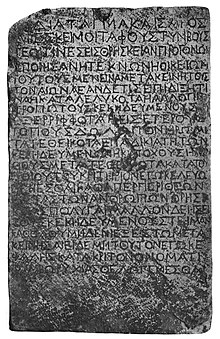
The Nazareth Inscription or Nazareth decree is a marble tablet inscribed in Greek with an edict from an unnamed Caesar ordering capital punishment for anyone caught disturbing graves or tombs.[1] It is dated on the basis of epigraphy to the first half of the 1st century AD. Its provenance is unknown, but a French collector acquired the stone from Nazareth. It is now in the collections of the Louvre.[2][3]
The text is read by scholars in the context of Roman law pertaining to exhumation and reburial, mentioned also by Pliny.[4][5] The inscription is of interest to some authors for its indirect relationship to Jesus of Nazareth, even though the text contains no reference to him. A 2020 study of the marble's isotopes showed that the tablet came from a quarry in the Greek island of Kos, casting much doubt on the theory that it has any relationship to Jesus, and it may instead have been inscribed as a reaction to the desecration of the grave of the Kos tyrant Nikias circa 20 BCE.[6]
- ^ Gager, John G. (1992). Curse tablets and binding spells from the ancient world. New York u.a.: Oxford Univ. Press. p. 179. ISBN 9780195062267.
- ^ Smallwood, E. Mary (1976). The Jews under Roman Rule: From Pompey to Diocletian: A Study in Political Relations. Leiden: Brill. p. 213.
- ^ Millard, Alan (2000). Reading and writing in the time of Jesus. New York, NY: New York Univ. Press. p. 110. ISBN 9780814756379.
- ^ Pliny, Epistles 10.68f.
- ^ Phillips, C. Robert (2007), "Approaching Roman Religion: The Case for Wissenschaftsgeschichte", in Rüpke, Jörg (ed.), A companion to Roman religion ([Nachdr.]. ed.), Malden, Mass.: Blackwell, p. 14, ISBN 9781405129435
- ^ Gibbons, Ann (February 28, 2020). "Tablet thought to have guarded tombs after Jesus's death may not be what it seems". Science Magazine. Archived from the original on February 29, 2020. Retrieved February 29, 2020.